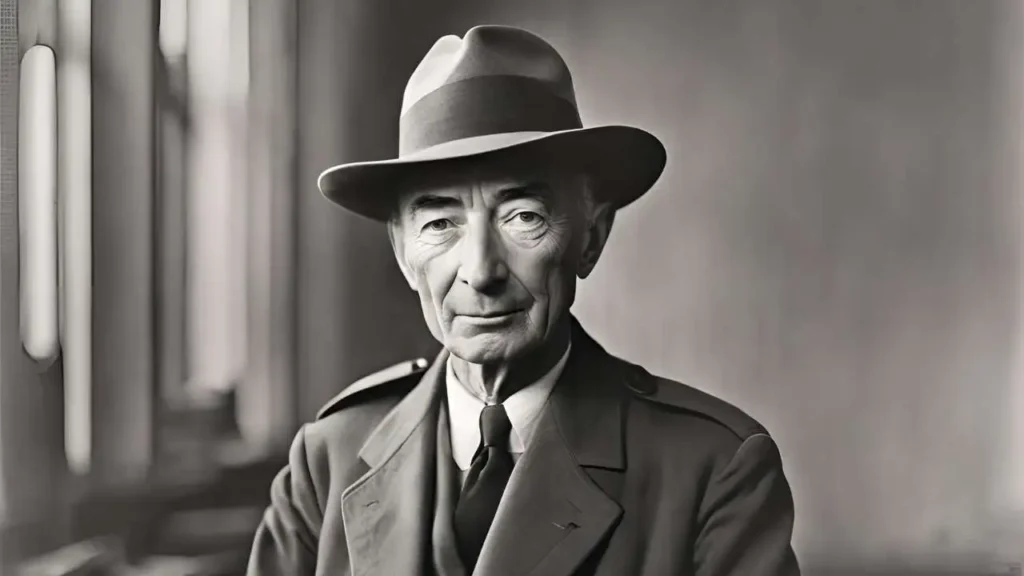The question of whether J. Robert Oppenheimer, the brilliant mind behind the Manhattan Project, had autism is both intriguing and complex. As interest in neurodiversity grows, so does curiosity about the mental states of historical figures who have shaped our world.
These figures through the lens of modern psychology offers a unique perspective on their lives and achievements.
This exploration not only sheds light on Oppenheimer’s personality but also enriches our comprehension of autism’s impact across different eras.
Who Was J. Robert Oppenheimer?
J. Robert Oppenheimer is best known for his pivotal role in the Manhattan Project during World War II. As the scientific director, he led the effort to develop the atomic bomb, a task that required immense coordination and innovation.
This project not only changed the course of the war but also marked a significant turning point in modern science and global politics.
Contributions to Physics and Nuclear Science
Beyond his wartime achievements, Oppenheimer made substantial contributions to theoretical physics and nuclear science.
He explored quantum mechanics and atomic structure, helping to lay the groundwork for future advancements.
His work left a lasting impact on the scientific community, influencing research and development in the field of nuclear energy and beyond.
Oppenheimer’s Personality Traits
J. Robert Oppenheimer was a complex individual whose personality traits left a lasting impression on those around him. Known for his brilliance and intellectual prowess, Oppenheimer’s character was marked by a mix of distinct qualities:
- Intellectual Curiosity: He had an insatiable thirst for knowledge, often diving deep into various subjects, from science to literature.
- Introspective Nature: Oppenheimer was introspective, frequently reflecting on his thoughts and experiences.
- Charismatic Leadership: Despite his often reserved demeanor, he possessed a charisma that inspired his colleagues.
There were also peculiar behaviors that caught the attention of his contemporaries. He was known to be socially awkward at times, with some accounts describing him as aloof or distant.
In “American Prometheus,” a biography of Oppenheimer, it is noted that he could be “unsettlingly intense,” often lost in his own thoughts and ideas.
These traits and behaviors have fueled speculation about Oppenheimer’s neurodiversity, prompting discussions on whether he might have exhibited characteristics associated with autism.
These facets of his personality provides insight into his unique contributions and challenges.
Social Interactions and Relationships
J. Robert Oppenheimer’s social interactions were often a blend of complexity and brilliance. Described by colleagues as “the most extraordinary mind of his generation,” Oppenheimer’s relationships were as multifaceted as his intellect.
His interactions were marked by a mix of intense focus and occasional aloofness, leading some to perceive him as distant.
With peers, Oppenheimer was known for his intellectual debates, often engaging in deep discussions that could be overwhelming for some.
Despite this, he managed to build strong professional relationships, particularly during his leadership at the Manhattan Project.
Yet, his social skills were sometimes described as “unsettling,” as he could be intensely absorbed in his thoughts, making personal connections challenging.
In his family life, Oppenheimer’s relationship with his wife, Katherine, and their children was equally complex. He was a devoted father but struggled with balancing his intense work commitments and personal life.
His brother, Frank Oppenheimer, once noted that Robert “lived more in his mind than in reality,” a reflection of how his intellectual pursuits often overshadowed personal interactions.
These nuances in Oppenheimer’s social life contribute to the ongoing discourse on his potential neurodiversity.
Evidence For and Against Autism
Several characteristics of J. Robert Oppenheimer’s personality have led some to speculate about his potential autism.
His intense focus on theoretical physics and his ability to immerse himself deeply in complex problems are traits often associated with individuals on the autism spectrum.
Furthermore, his social interactions were marked by peculiarities, such as difficulty sustaining personal relationships and a tendency towards aloofness.
Research on historical figures and autism suggests that many individuals who excelled in scientific fields often displayed traits now recognized as part of the autism spectrum.
A 2015 study found that individuals with exceptional abilities in particular areas sometimes possess characteristics that align with autism, which could support the idea of Oppenheimer’s neurodiversity.
On the other hand, there are counterarguments that challenge this notion. Critics argue that Oppenheimer’s behavior can be attributed to the intense pressure and stress associated with his role in the Manhattan Project, rather than autism. A
His ability to lead and collaborate with a diverse team during such a critical project may suggest strong adaptive social skills.
The retrospective diagnosis of historical figures is fraught with challenges, as modern diagnostic criteria differ significantly from past understandings, complicating any posthumous evaluation.
The Challenges of Diagnosing Historical Figures
Diagnosing historical figures like J. Robert Oppenheimer with conditions such as autism is inherently challenging.
One primary difficulty is the lack of direct evidence. Without the opportunity to observe behaviors firsthand or conduct interviews, historians are left to rely on second-hand accounts, letters, and reports that might not accurately capture the nuances of someone’s personality or mental health.
The criteria for diagnosing autism have evolved significantly over the decades. In Oppenheimer’s time, understanding of neurodiversity was limited.
The diagnostic frameworks we use today were not available, and behaviors that might now be recognized as indicative of autism could have been interpreted differently.
Traits such as intense focus or social awkwardness might have been seen merely as quirks of a brilliant mind. As we attempt to apply modern diagnostic criteria to historical figures, we must consider these changes.
This evolution in understanding highlights both the progress in recognizing neurodiversity and the complexities of applying contemporary labels to individuals from the past.
Why It Matters
Exploring the possibility that figures like J. Robert Oppenheimer might have been neurodiverse is significant for several reasons.
Firstly, it broadens our understanding of how diverse minds have shaped history. Recognizing neurodiversity in historical figures challenges the conventional narratives that often overlook the unique contributions of those who think differently.
“Understanding the neurodiversity of historical figures can offer valuable insights into the varied ways in which brilliance can manifest, beyond the traditional norms,”
notes Dr. Emily Richards, a neurodiversity expert. This perspective encourages a more inclusive view of intelligence and creativity.
These discussions impact our current understanding of autism by normalizing the presence of neurodiversity in all walks of life, including among historical geniuses.
It can foster greater acceptance and appreciation in modern society, where individuals with autism continue to face challenges.
In the field of science, recognizing the contributions of neurodiverse individuals encourages innovation by embracing different perspectives.
By exploring such possibilities, we not only honor the past but also pave the way for a more inclusive future, where diverse minds are celebrated for their unique insights and contributions.







